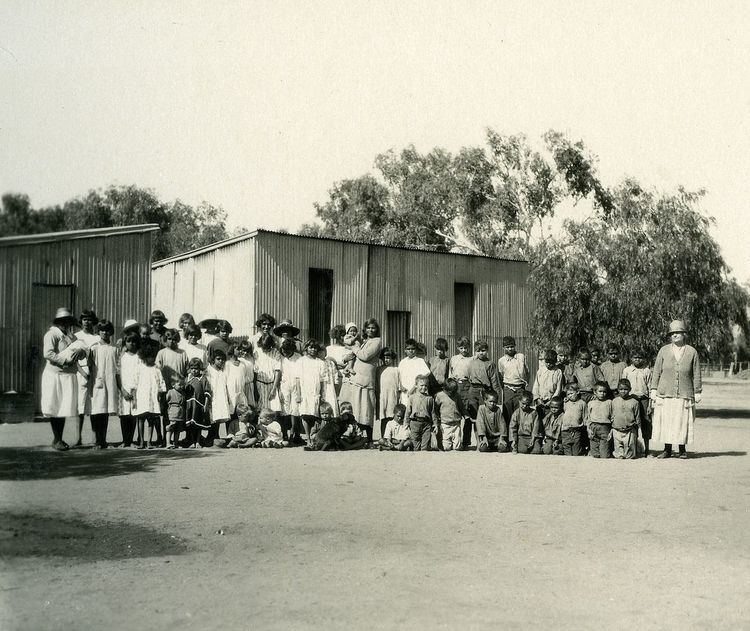 | ||
The Bungalow was an institution for part-Aboriginal children established in 1914 in Alice Springs in the Northern Territory of Australia. It existed at several locations in Alice Springs (then Stuart), Jay Creek and the Alice Springs Telegraph Station.
Contents
Background
From 1911 the Commonwealth Government gained control of the Northern Territory from South Australia. It then came under the jurisdiction of the Department of External Affairs. In July 1913, Senior Constable Robert Stott in Stuart (now Alice Springs) wrote to the Secretary of the Department of External Affairs Atlee Hunt describing the need for a government school in the town. In January 2014, the Administrator of the Northern Territory J.A. Gilruth visited Stuart. He also stated his belief that the government should provide a school, noting that "there would be eleven school age white children, four quadroons and some half caste children" who should receive some sort of education. He proposed the erection of a teacher's residence with classroom attached.
In March 2014, Stott telegraphed Gilruth advising that a building where he kept rations for Aboriginal people, could be converted temporarily into a classroom. On the same day Gilruth advised that arrangements were being made with the South Australian Director of Education to procure a teacher. The first teacher was Ida Standley who departed for Stuart from Adelaide, South Australia on 6 May 1914. Her salary was £150 per annum. The school opened in June with 25 students. It became known as 'The Bungalow'. Standley taught the white children for four-and-a-half hours each morning at the police station. After lunch, 14 'half-caste' children joined her class for one-and-a-half hours. Standley sometimes provided evening classes to 'half-caste' adults at the institution.
Overnight the children were cared for by Topsy Smith. An Arabana woman, Smith arrived in Stuart in 1914, after the death of her partner, a miner working in Arltunga. Smith and seven of her eleven 'half-caste' children, were given a tent by Stott, who informed the Administrator that there was no other accommodation for her family. He suggested that two township allotments near the Police Station should be reserved for half-castes. The Administrator agreed to this, and authorised the building of an iron shed. Topsy Smith was placed in charge of it under the supervision of Sergeant Stott. Topsy's Smith's eldest child was Walter Smith, the well-known Central Australian bushman. In 1914, Standley agreed to accept the position of matron with an extra remuneration of £50 per annum, and they began working together.
Jay Creek
The number of students grew to over 60 and there were increasing concerns over conditions at The Bungalow. In June 1925 the Secretary of the Aborigines Friends Association John H. Sexton stated "the environment of the Bungalow for half caste children is not conducive to their best interests". A new site of 25 miles2 was identified at Jay Creek. In November 1928, Standley moved to Jay Creek with the Bungalow children. Pearl Burton was soon to take up duty at the school in town. By 1932, the institution had "water problems" and a new site was proposed at the Alice Springs Telegraph Station.
Alice Springs Telegraph Station
In 1932, The Bungalow moved to the old Alice Springs Telegraph Station. The building was disused after the construction of a post office the same year. The area of the telegraph station was proclaimed an Aboriginal Reserve on 8 December 1932 with an area of 273 hectares. The Freemans were the first Superintendent and Matron at the new location. Classes were held in the Battery Room, the stables were converted to an ablutions block and a dormitory was built between the Barracks and the stables. The Telegraph Office became the caretakers cottage. The Bungalow closed in 1942 when children were evacuated south in response to World War II. The majority of the children from the institution were sent south to Mulgoa in New South Wales and Balaklava in South Australia.
